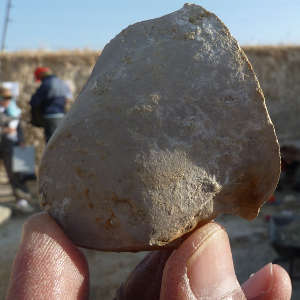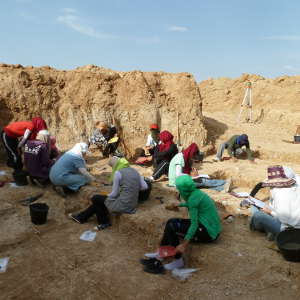River subbasins more depleted than
official figures show
09 April 2024
Published online 4 December 2018
Hundreds of stone tools and cut-marked animal bones found in Algeria provide evidence that the early ancestors of humans began manufacturing tools in North Africa earlier than previously thought — and they were skilled butchers.

Mohamed Sahnouni
Clear cut marks observed on animal bones buried in sediment layers at Ain Boucherit, an excavation site located 100 kilometres inland from the Mediterranean Sea in eastern Algeria, testify that hominins used sharpened tools to carve out meat from carcasses, revealing a level of technological advancement that surprised the scientists.
“North African hominins’ sophisticated stone technology allowed them to successfully compete with carnivores for meat acquisition,” says Mohamed Sahnouni, coordinator of an investigation of prehistoric technology at the National Center for the Investigation of Human Evolution (CENIEH) in Burgos, Spain. Ain Boucherit has produced the largest known sample of excavated materials from a single site, he says, allowing stronger inferences to be made on how hominins butchered animal carcasses.
The Algerian Oldowan tools, named after Olduvai, the Tanzanian site where the first prehistoric stone tools were found in the 1930s, closely resemble the East African ones. They were manufactured just 200,000 years later than the most ancient prehistoric stone tools ever identified in East Africa. “The similarity tells us that, in both regions, early hominins had a good knowledge of rock flaking physical properties,” Sahnouni says.

Mohamed Sahnouni
Max Planck evolutionary anthropologist Shannon McPherron, who was not involved in the study, believes that stone tools could have been independently invented several times over. “It is quite possible that a technology as simple as this could have been invented at certain times and places and then lost, before being reinvented again at a later stage,” he says.
So far, the finds in Ain Boucherit haven’t procured evidence of hunting, or yielded hominins’ fossilized remains. However, based on the potential of Ain Boucherit and the adjacent sedimentary basins, the scientists suggest that hominin fossils and Oldowan artefacts as old as the East African ones could be discovered in North Africa.
doi:10.1038/nmiddleeast.2018.153
Sahnouni, M. et al. 1.9-million- and 2.4-million-year-old artifacts and stone tool-cutmarked bones from Ain Boucherit, Algeria. Science http://dx.doi.org/10.1126/science.aau0008 (2018).
Stay connected: